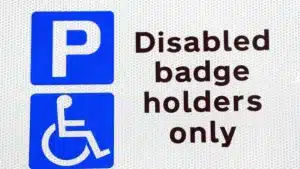The blue badge permit was setup to allow people with mobility issues to park their car close to shopping, entertainment and work facilities. It allows drivers, or their blue badge holding passenger to park in allocated parking spaces free of charge. It also allows blue badge holders to park on double yellow lines for up to three hours as long as there are no restrictions are in force*.
How to apply
You apply for a blue badge at your local authority. If you’ve previously been refused a blue badge you can appeal or re-apply using the same procedure, however, blue badges are issued based on symptoms of mobility rather than on diagnosis of a specific condition. For example, a diagnosis of asthma, multiple sclerosis or incontinence may not automatically qualify you.

Grounds for eligibility are based on;
Permanent and sustainable difficulty in walking or inability to walk. This means you are physically unable to walk through mechanical means or you experience excessive pain or breathlessness caused by the effort to walk. Your council will ask a series of questions based on this fundamental qualifying factor and they may ask you to meet with a medical professional to assess your condition.
Severe disability in both arms. You may be eligible for a blue badge if you regularly drive and have considerable difficulty parking or using parking meters caused by severe disability in both arms. Most drivers who qualify under this criterion will have a steering wheel adaptation in their car. Drivers will not quality on the basis that they have difficulty in carrying shopping or any other items short/long distances when travelling to services.
You may automatically qualify for a badge if you meet any of the following conditions;
- You receive compensation from the Armed forces scheme and have been assessed and certified as having considerable difficulty in walking.
- You receive a War Pensioner’s Mobility Supplement.
- If you have a child under three years old who has a medical condition that requires them to be accompanied by bulky or heavy equipment; or a child that needs to be near transport in case of emergencies.
- If you are in receipt of the Higher Rate of the Mobility Component of the Disability Living Allowance.
- If you are registered as blind and have severely impaired sight.
- You may be eligible for an organisational blue badge if you regularly transport multiple people who would be eligible to receive a blue badge permit in their own right. An example would be a minibus for a hospice or nursing home.
Please note these lists are not exhaustive and you will need to supply the correct documentation to the local authority in which you are applying.
Applying for a Blue Badge
You can apply online for a permit at gov.uk/apply-blue-badge or you can call the enquiry support service on 0844 463 0213. Alternatively, you can call your local authority and ask for the blue badge section who will send an application form to you in the post.
You will need a recent passport approved photo, passport or driving license and details of any benefits you currently receive. If you are re-applying for a badge you will need particulars of the expired badge.
Blue Badge Rejection
If your application is rejected, you can appeal the decision with the local authority If you believe that they have not taken all the facts into consideration. The local authority may refuse to issue a permit If you do not supply enough evidence to support your application or they suspect the badge might not be used correctly.
*check with your local authority for latest rules and restrictions



